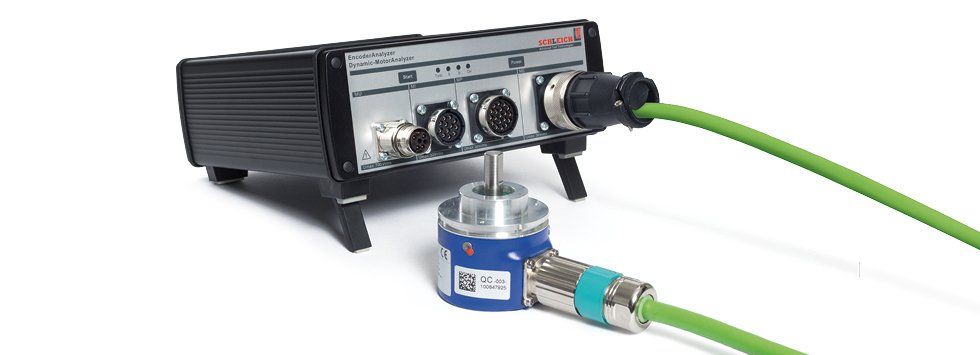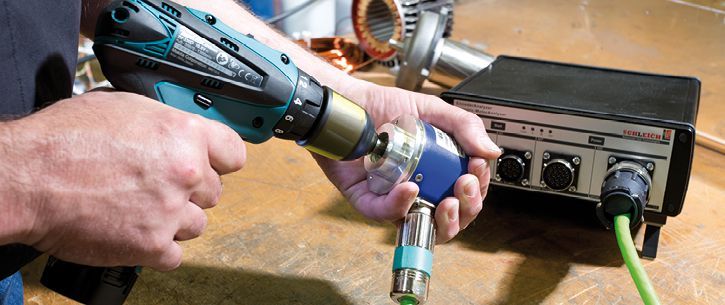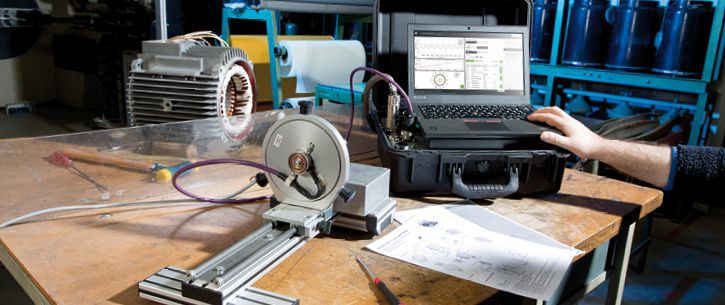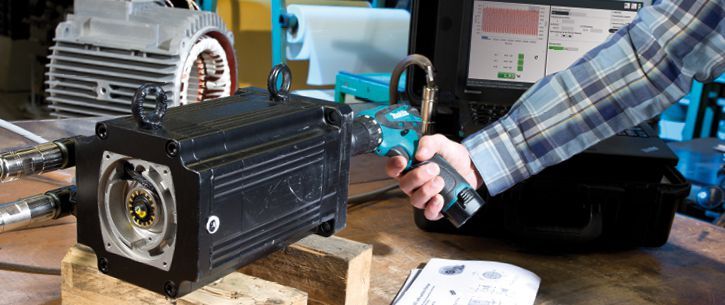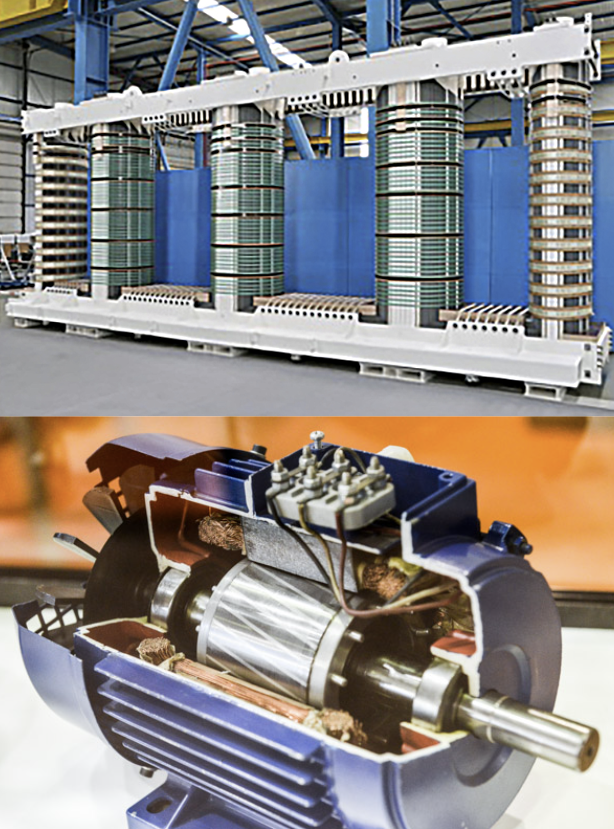Encoder Analyzer Inspecting and adjusting encoders
Check and adjust all types of electric motor encoders with the SCHLEICH-Encoder Analyzer.
And it’s as easy as that: Connect the encoder to the Encoder Analyzer directly or via a connection box and enter the technical data of the encoder. The Encoder Analyzer supplies the encoder with the necessary voltage, checks the current consumption and measures all signals.
The functional principle – incredibly simple
The EncoderAnalyzer consists of two components: The measuring module and the analysis software that is installed on a PC. The EncoderAnalyzer provides valuable services. It facilitates the encoder test well by providing voltage to the rotary encoder and
measuring and evaluating the signals. At the end you receive clear GO or NO GO result. On the PC screen, the Encoder Analyzer shows you a clear analysis and possible encoder errors. In addition, you receive a meaningful graphical representation of all encoder signals, just like an oscilloscope.
EncoderAnalyzer Details:
The functional principle – genious and simple.
Modern drives are often equipped with rotary encoders. For the operator, a detailed inspection is made difficult due to the large diversity of encoders in the market. This applies in particular for repairers of electric motors but also for analyses in production. An extensive inspection without special measuring technology is not possible.
The EncoderAnalyzer offers valuable services by simplifying the encoder inspection as it supplies the encoder with voltage and measures all signals. Afterwards they are automatically evaluated. The result is indicated either as a clear GO (o.k. ) or a clear NOGO (not o.k.).
The following rotary encoders and sensor systems may be inspected:
Incremental square wave encoders with A, /A, B, /B, N, /N, U, /U, V, /V, W, /W6-channel EncoderAnalyzer
Sine-cosine encoders with sin, /sin, cos, /cos, N, /N
Hall elements with A, /A, B, /B, N, /N
Hall elements with U, /U, V, /V, W, /W
Commutation signals / block commutation
Multiturn-absolute encoders with SSi- and Hiperface-interface
optional resolvers
optional 3-phase motor current measurment during operation
optional EMF-voltage measurement up to 700V
optional resolver adjustment regarding the moto´s EMF
optional programming the rotary encoder´s angle offset
The functional principle.
The EncoderAnalyzer consists of two components: The measuring module and the analysing software, which is to be installed on a PC.
The measuring module provides a connection for the encoders to be inspected. Furthermore, additional components for supplementary measuring functions may be connected to the measuring module.
The measuring module performs the tests. For this, it determines millions of measuring values during one revolution and transfers them to a PC. The communication between measuring module and PC is done by a Gigabit-Ethernet connection. By means of the analyzing software the measured results are automatically evaluated. At the end of an inspection the software presents the result on the screen. For a better understanding, errors detected at a broken rotary encoder, are graphically displayed like in an oscilloscope.
The test results are stored in a database. If requested, a detailed test report may be printed.
Connecting the rotary encoder
The rotary encoder to be inspected is connected with the measuring module by a measuring lead. On the measuring module´s front side up to 2 measuring sockets are available for the connection of the measuring leads. verbunden. The number of measuring sockets depends on the ordered options. The EncoderAnalyzer with all 12 measuring channels is equipped with 2 measuring sockets.
A voltage supply of 3…30 V is also integrated in the EncoderAnalyzer. Depending on the encoder, voltage level and maximum permissible power consumption are entered by the operator via software input. During the measurement the EncoderAnalyzer monitors the power consumption. In case the maximum permissible value is exceeded, the voltage supply is automatically switched off.
Measuring socket MU for
three high-voltage measuring inputs
Measuring socket MI for
three current measuring inputs for current clamps
Measuring socket MP for
resolvers
Measuring socket ME for
Incremental square-wave encoders
Sine-cosine encoders
Hall elements
Commutation signals/ Block commutation
Encoder´s voltage supply
Communication – and programming interface
The analysis software
The fast and intelligent measuring technology and the user-friendly, intuitive analysis software are perfectly matched with each other. Only a few settings and selections are sufficient, to configure the measurement for the encoder to be tested.
The extensive evaluations lead to clear and easy-understandable results. Special or detailed knowhow is not necessary while dealing with the analysis software. The software helps and supports during the connection and evaluation of encoders.
As supplement to the encoder analysis the software also assists during the angle adjustment of rotary encoders. No matter, if the rotary encoder needs to be adjusted by mechanical turning or if only the angle offset needs to be determined, the software graphically supports the operator during the adjustment. Depending on the encoder type and the EncoderAnalyzer´s equipment, the offset angle may also be written in the rotary encoder.
Measuring principles for the encoder inspection
1. Rotary encoder- / Resolver test
The rotary encoder is connected with the measuring module with an appropriate connection lead. Afterwards you manually turn the encoder´s axis. The arising impulses are digitized and evaluated by the measuring module.
2. Rotary encoder- / Resolver test together with the motor
The rotary encoder mounted on the motor is connected with the measuring module with an appropriate connection lead. Afterwards the motor is directly operated from the mains or via a frequency converter. The arising impulses are digitized and evaluated by the measuring module.
3. Rotary encoder- / Resolver test by means of a test installation
In a special SCHLEICH-test installation the rotary encoder is mechanically coupled with a small drive motor. Via an appropriate connection lead it is connected with the measuring module. For testing purposes the module actuates the drive motor. The arising impulses are digitized and evaluated by the measuring module. Depending on the encoder to be tested the motor´s angle position may also be determined.
4. Resolver- / Hall element adjustment
For the adjustment the resolver, which is still connected with the motor, is additionally connected with the measuring module via an appropriate connection lead. Furthermore the motor is mechanically coupled by a drive motor. Afterwards the drive motor is directly operated from the mains or, better, by a frequency converter. The arising pulses and the Back-EMF induced in the windings are digitized and evaluated by the measuring module. The measuring module derives the adjustment-information from the measured values which is also indicated on the screen.
Voltage supply for the encoder
For testing purposes, the encoder has to be supplied with DC-voltage which is generated in the measuring module and in the requested voltage level. The supply voltage is shortcircuit proof and the encoder´s power consumption is also inspected. In case the power consumption is too high, the measuring module automatically switches-off the supply voltage due to safety reasons.
Database
The software is equipped with a database with storage capacity for thousands of encoders and resolver.
For the inspection of an encoder, the corresponding data has to be contained in the database. The data consists of relevant information as e.g. the encoder type, the supply voltage level, the pin assignment and so on. Based on this information, the software assists you regarding the suitable connection cable and how to properly connect the encoder.
Furthermore the database contains even more information. Although they are not important for the measurements, they inform about further details of the encoder.
All in One – Encoder analysis.
Encoder analysis without special knowledge
Automatic inspection of all encoder signals
Inspection of all signal pulses per revolution
Determination of number of pulses per revolution
Inspection of all 90 degree-phase shifts between signals per revolution
automatic inspection of all signal voltages per revolution
Sense of rotation and encoder speed
Angle fault per revolution
Angle balance of rotary encoders
EMF-measurement at all three motor phases to adjust resolvers, encoders or hall elements
Storing the angle offset in the rotary encoder via data interface
EMF-measurement to determine the ke-value (voltage constant) during run-out and standardization to 1000 rpm
EMF-symmetry measurements during run-out
Incremental encoder test with A – /A – B – /B – Z – /Z channels
Sine- Cosine-rotary encoder test with sin – /sin – cos – /cos – N – /N channels
Resolver-tests
Hall element-test, evaluation of the three commutation signals
Encoder interfaces via SSi, EnDat, Hiperface
Measuring module with 6 or 12 high-speed-measuring channels
Integrated adjustable voltage supply for encoders
Integrated reference signal source for resolvers
Windows®-Software to evaluate the measuring signals
Measuring signals displayed similar to an oscilloscope
SQL-database for encoder types, sorted by manufacturer and type
Multilingual user interface
Benefits at a glance.
General information
Worldwide voltage supply 90–250 V, 47–63 Hz
Dimensions W 20 x D 20 x H 5 cm
weight 1 kg
Operating temperature 10°–50° Celsius
Storing temperature-20°–60° Celsius
Encoder
Measuring inputs
6 x or optional 12 x analog inputs
Measuring range 0–30 V
Measuring signals A – /A – B – /B – Z – /Z
Measuring signals sin – /sin – cos – /cos – ref – /ref
Measuring signals K1 – /K1 – K2 – /K2 – K3 – /K3
Resolver
Excitation output
1 x analog output
Voltage range 0-10 V
Frequency range1-10 KHz
Measuring inputs
2 x analog inputs
Measuring range 0–30 V
Measuring signals sin – /sin – cos – /cos
Single- and Multiturn encoders
Measuring inputs
6 x analog inputs
Measuring range 0–30 V
Measuring signals sin – /sin – cos – /cos – ref – /ref
Protocol data interfaces
Hiperface
SSi
EnDat 2.2 – bidirectional
EMF-Measurement
Measuring inputs
3 x analog inputs
measuring range 0–700 Veff
internal virtual neutral point
fuses integrated in the tester
fuses integrated in the test probes



